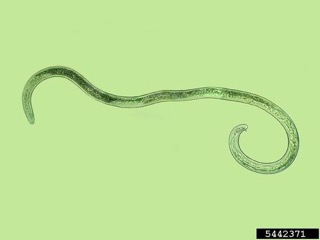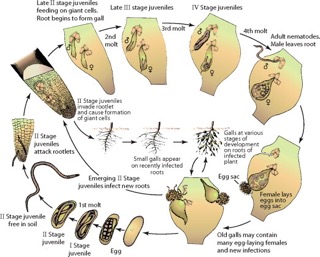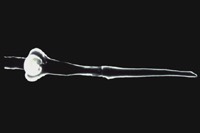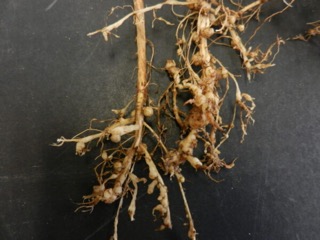Meloidogyne Incognita: Difference between revisions
| Line 45: | Line 45: | ||
[[File: Galls.jpeg |500px|thumb|right| This shows multiple galls effecting a root system. [7]]] | [[File: Galls.jpeg |500px|thumb|right| This shows multiple galls effecting a root system. [7]]] | ||
Root-Knot Nematodes are parasitic and have a very negative impact on plants and their roots. When they infect cells in the roots of plants, galls will form on the roots, which are large lumps on the root, ranging in size from 1-10mm. These galls can cause [[decomposition]] or decay, and make these roots more vulnerable to other fungi and parasites that are in the soil. This causes damage to the root system and the plant's ability to thrive and grow above the soil. These Nematodes are some of the most invasive and harmful parasites to farmers as they attack many vegetable species. Due to them being unviewable by the human eye and the roots being underground, it is hard for farmers to know what is damaging their crops and [[agriculture]]. Also, these nematodes don't move, so once the plant is infected, it will not be able to recover. This leads to scientists struggling to find an effective way to reduce these nematodes. So far, pesticides and chemicals are the most efficient way, but they cause other harmful side effects.[6] | Root-Knot Nematodes are parasitic and have a very negative impact on plants and their roots. When they infect cells in the roots of plants, galls will form on the roots, which are large lumps on the root, ranging in size from 1-10mm. These galls can cause [[decomposition]] or decay, and make these roots more vulnerable to other fungi and parasites that are in the soil. This causes damage to the root system and the plant's ability to thrive and grow above the soil. These Nematodes are some of the most invasive and harmful parasites to farmers as they attack many vegetable species. Due to them being unviewable by the human eye and the roots being underground, it is hard for farmers to know what is damaging their crops and [[agriculture]]. The effects seen on the surface by these nematodes, like the plant wilting or being small in size, can also be mistaken for other common plant diseases. Also, these nematodes don't move, so once the plant is infected, it will not be able to recover. This leads to scientists struggling to find an effective way to reduce these nematodes. So far, pesticides and chemicals are the most efficient way, but they cause other harmful side effects.[6] | ||
== References == | == References == | ||
Revision as of 09:45, 18 April 2025
Taxonomy
| Domain | Kingdom | Phylum | Class | Order | Family | Genus | |
|---|---|---|---|---|---|---|---|
| Classification | Eukaryota | Animalia | Nematoda | Chromadorea | Tylenchida | Heteroderidae | Meloidogyne |
The Taxonomy of the Meloidogyne Incognita, also commonly called Southern Root-Knot Nematodes [1]

Appearance & Life Cycle
Root-Knot Nematodes have multiple juvenile stages in their lifetime. In their earliest juvenile forms, male and female nematodes are vermiform, meaning they appear like skinny worms. These nematodes grow through molting and shedding their outer layer to allow them to increase in size. Adult males keep the worm shape, whereas females grow into a more spherical shape as they grow. These nematodes grow to be 1/10 the size of a pinhead and are too small to be seen by the human eye, they're also transparent. Females plant their eggs at the root surface in the soil.[2]

Habitat
Root-Knot Nematodes can be found in the soil worldwide, thriving especially in areas where the climate is hot with winters that are short and not severe drops in temperature. Greenhouses make for the perfect area for these Nematodes to reproduce.[4] Male nematodes move throughout the soil and leave the roots of a plant to go and obtain nutrients. Female's however, stay in a certain area of the root and feed there their whole life until it is time to reproduce. Once they are big enough to reach the top of the root surface, they lay their eggs in the soil. These nematodes are endogeic, meaning they spend their whole lives in the soil. [2]
The Stylet & How it Works
Root-Knot Nematodes possess a stylet that all plant-parasites have that aids in their getting nutrients from the plant roots. This stylet sticks out and is used to inject secretions and ingest nutrients from the roots and soil. When the Nematode first penetrates a root cell, it secretes secretory proteins into the cell. These parasitized cells are great "giant cells", meaning that the nucleus of the cell continues to grow and create multiple nuclei, but the cell will never divide. This benefits the nematode because they know they will stay at this point and continue to feed on the now more abundant and easily accessible proteins from the large nucleus. A feeding tube is secreted from the stylet that goes into the plant cytoplasm to filter and obtain cytosol, which is what they feed on. This allows the nematodes not to have to move, but still have the necessary nutrients to survive.[5]

Impacts of Root-Knot Nematodes

Root-Knot Nematodes are parasitic and have a very negative impact on plants and their roots. When they infect cells in the roots of plants, galls will form on the roots, which are large lumps on the root, ranging in size from 1-10mm. These galls can cause decomposition or decay, and make these roots more vulnerable to other fungi and parasites that are in the soil. This causes damage to the root system and the plant's ability to thrive and grow above the soil. These Nematodes are some of the most invasive and harmful parasites to farmers as they attack many vegetable species. Due to them being unviewable by the human eye and the roots being underground, it is hard for farmers to know what is damaging their crops and agriculture. The effects seen on the surface by these nematodes, like the plant wilting or being small in size, can also be mistaken for other common plant diseases. Also, these nematodes don't move, so once the plant is infected, it will not be able to recover. This leads to scientists struggling to find an effective way to reduce these nematodes. So far, pesticides and chemicals are the most efficient way, but they cause other harmful side effects.[6]
References
[1] IPM Images. “Root-Knot Nematode.” IPM Images, [[1]].
[2] University of Wisconsin-Madison. “Root Knot Nematode.” University of Wisconsin-Madison Extension, [[2]].
[3] North Carolina State University Cooperative. “Management of Root-Knot Nematodes in Bedding Plants.” North Carolina State University Cooperative Extension, [[3]].
[4] ScienceDirect. “Root-Knot Nematodes.” ScienceDirect, [[4]].
[5] American Phytopathological Society. “Root-Knot Nematode.” APS Net, [[5]].
[6] Business Queensland. “Root-Knot Nematode.” Business Queensland, [[6]].
[7] ScienceDirect. “Root-Knot Nematodes.” ScienceDirect, [[7]].